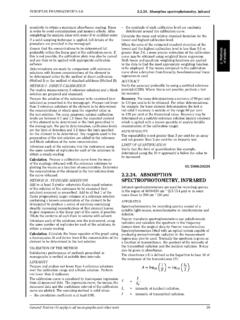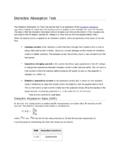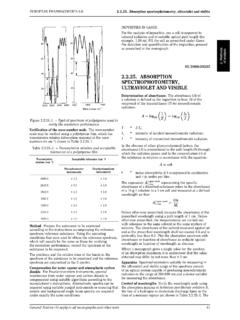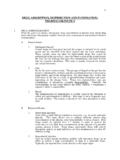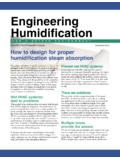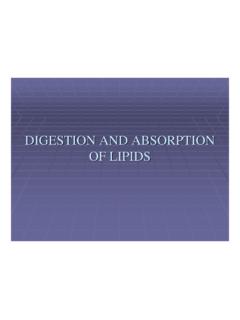Transcription of Atomic absorption spectrometry - Home - Liskeard …
1 1 Atomic absorption spectrometryAtomic absorption spectrometry (AAS) is ananalytical technique that measures theconcentrations of elements. Atomic absorption is sosensitive that it can measure down to parts per billionof a gram ( g dm 3) in a sample. The techniquemakes use of the wavelengths of light specificallyabsorbed by an element. They correspond to theenergies needed to promote electrons from oneenergy level to another, higher, energy absorption spectrometry has many uses indifferent areas of analysis. Analysing metals in biologicalfluids such as blood and analysis. Monitoring ourenvironment eg finding out the levels of variouselements in rivers, seawater, drinking water, air,petrol and drinks such as wine, beer and fruit In some pharmaceuticalmanufacturing processes, minute quantities of acatalyst used in the process (usually a metal) aresometimes present in the final product. By usingAAS the amount of catalyst present can Many raw materials are examined andAAS is widely used to check that the major elementsare present and that toxic impurities are lower thanspecified eg in concrete, where calcium is a majorconstituent, the lead level should be low because it By using AAS the amount of metals such asgold in rocks can be determined to see whether it isworth mining the rocks to extract the 2atoms there is in the vapour, the more radiation isabsorbed.
2 The amount of light absorbed isproportional to the number of lead atoms. Acalibration curve is constructed by running severalsamples of known lead concentration under the sameconditions as the unknown. The amount thestandard absorbs is compared with the calibrationcurve and this enables the calculation of the leadconcentration in the unknown an Atomic absorption spectrometerneeds the following three components: a light source;a sample cell to produce gaseous atoms; and a meansof measuring the specific light light sourceThe common source of light is a hollow cathodelamp (Fig. 1). This contains a tungsten anode and acylindrical hollow cathode made of the element to bedetermined. These are sealed in a glass tube filledwith an inert gas eg neon or argon at a pressure ofHow it worksAtoms of different elements absorb characteristicwavelengths of light. Analysing a sample to see if itcontains a particular element means using light fromthat element.
3 For example with lead, a lampcontaining lead emits light from excited lead atomsthat produce the right mix of wavelengths to beabsorbed by any lead atoms from the sample. InAAS, the sample is atomised ie converted intoground state free atoms in the vapour state and abeam of electromagnetic radiation emitted fromexcited lead atoms is passed through the vaporisedsample. Some of the radiation is absorbed by the leadatoms in the sample. The greater the number ofFigure 1+-1. IonisationNe Ne++-2. SputteringNe++-3. ExcitationM*Ne++-4. EmissionM M*M M Lightbetween 1 Nm 2 and 5 Nm 2. The ionisation of somegas atoms occurs by applying a potential difference ofabout 300 400 V between the anode and thecathode. These gaseous ions bombard the cathodeand eject metal atoms from the cathode in a processcalled sputtering. Some sputtered atoms are inexcited states and emit radiation characteristic of themetal as they fall back to the ground state egPb* Pb + h (Fig.)
4 2). The shape of the cathodeconcentrates the radiation into a beam which passesthrough a quartz window, and the shape of the lampis such that most of the sputtered atoms areredeposited on the cathode. 2A typical Atomic absorption instrument holdsseveral lamps each for a different element. The lampsare housed in a rotating turret so that the correctlamp can be quickly optical system and detectorA monochromator is used to select the specificwavelength of light ie spectral line which isabsorbed by the sample, and to exclude otherwavelengths. The selection of the specific light allowsthe determination of the selected element in thepresence of others. The light selected by themonochromator is directed onto a detector that istypically a photomultiplier tube. This produces anelectrical signal proportional to the light intensity(Fig. 3).Double beam spectrometersModern spectrometers incorporate a beam splitter sothat one part of the beam passes through the samplecell and the other is the reference (Fig.
5 4). Theintensity of the light source may not stay constantduring an analysis. If only a single beam is used to passthrough the atom cell, a blank reading containing noanalyte (substance to be analysed) would have to betaken first, setting the absorbance at zero. If theintensity of the source changes by the time thesample is put in place, the measurement will beinaccurate. In the double beam instrument there is aFigure 3constant monitoring between the reference beam andthe light source. To ensure that the spectrum does notsuffer from loss of sensitivity, the beam splitter isdesigned so that as high a proportion as possible ofthe energy of the lamp beam passes through of the sampleTwo systems are commonly used to produce atomsfrom the sample. Aspiration involves sucking asolution of the sample into a flame; andelectrothermal atomisation is where a drop of sampleis placed into a graphite tube that is then instruments have both atomisation systemsbut share one set of lamps.
6 Once the appropriate lamphas been selected, it is pointed towards one or otheratomisation beamSample beamSample cellBeam recombinerMonochromatorDetectorElectroni csReadoutSourceBeam splitterSample CellMonochromatorDetectorMeterSourceChop perFlame(or furnace)Figure 4 Flame aspirationFigure 5 shows a typical burner and spray (giving a flame with a temperature of2200 2400 C) or ethyne/dinitrogen oxide (2600 2800 C) are often used. A flexible capillary tubeconnects the solution to the nebuliser. At the tip ofthe capillary, the solution is nebulised ie brokeninto small drops. The larger drops fall out and drainoff while smaller ones vaporise in the flame. Onlyca 1% of the sample is capImpact beadMixing chamberwith burner headFlow spoilerFigure 7 Sample preparationSample preparation is often simple, and the chemicalform of the element is usually unimportant. This isbecause atomisation converts the sample into freeatoms irrespective of its initial state.
7 The sample isweighed and made into a solution by suitabledilution. Elements in biological fluids such as urineand blood are often measured simply after a dilutionElectrothermal atomisationFigure 6 shows a hollow graphite tube with a l of sample (ca 1/100th of a raindrop) is placedthrough the sample hole and onto the platform froman automated micropipette and sample changer. Thetube is heated electrically by passing a currentthrough it in a pre-programmed series of steps. Thedetails will vary with the sample but typically theymight be 30 40 seconds at 150 C to evaporate thesolvent, 30 seconds at 600 C to drive off any volatileorganic material and char the sample to ash, and witha very fast heating rate (ca 1500 C s-1) to 2000 2500 C for 5 10 seconds to vaporise and atomiseelements (including the element being analysed).Finally heating the tube to a still higher temperature ca 2700 C cleans it ready for the next this heating cycle the graphite tube is flushedwith argon gas to prevent the tube burning away.
8 Inelectrothermal atomisation almost 100% of thesample is atomised. This makes the technique muchmore sensitive than flame the original sample. Figure 7 shows a flame atomicabsorption spectrometer with an autosampler andflow injection making reference solutions of the elementunder analysis, for calibration, the chemicalenvironment of the sample should be matched asclosely as possible ie the analyte should be in thesame compound and the same solvent. Tefloncontainers may be used when analysing very dilutesolutions because elements such as lead are sometimesleached out of glass vessels and can affect the absorptionIt is possible that other atoms or molecules apart fromthose of the element being determined will absorb orscatter some radiation from the light source. Thesespecies could include unvaporised solvent droplets, orcompounds of the matrix (chemical species, such asanions, that tend to accompany the metals beinganalysed) that are not removed completely.
9 Thismeans that there is a background absorption as well asthat of the way of measuring and correcting thisbackground absorption is to use two light sources, oneof which is the hollow cathode lamp appropriate tothe element being measured. The second light sourceis a deuterium deuterium lamp produces broad bandradiation, not specific spectral lines as with a hollowLightSample holeFigure 6 Figure 54 Readers will find a more detailed explanation of Atomic absorption spectrometry in the forthcoming R. Levinson, MoreModern Chemical Techniques, RSC. For further information contact The Education Department, The RoyalSociety of Chemistry, Burlington House, Piccadilly, London W1J leaflet is produced in association with The Royal Society of Chemistry Fine Chemicals and Medicinals lamp. By alternating the measurements of thetwo light sources generally at 50 100 Hz thetotal absorption ( absorption due to analyte atoms plusbackground) is measured with the specific light fromthe hollow cathode lamp and the backgroundabsorption is measured with the light from thedeuterium lamp.
10 Subtracting the background from thetotal absorption gives the absorption arising from onlyanalyte calibration curve is used to determine the unknownconcentration of an element eg lead in a instrument is calibrated using severalsolutions of known concentrations. A calibrationcurve is produced which is continually rescaled asmore concentrated solutions are used the moreconcentrated solutions absorb more radiation up to acertain absorbance. The calibration curve shows theconcentration against the amount of radiationabsorbed (Fig. 8(a)).The sample solution is fed into the instrumentand the unknown concentration of the element eglead is then displayed on the calibration curve(Fig. 8(b)).Interferences and matrix modificationOther chemicals that are present in the sample mayaffect the atomisation process. For example, in flameatomic absorption , phosphate ions may react withcalcium ions to form calcium pyrophosphate.
